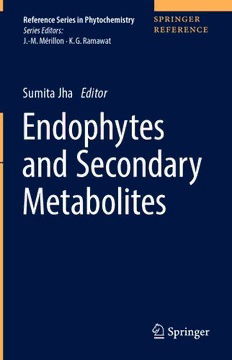
Endophytes and Secondary Metabolites PDF
Preview Endophytes and Secondary Metabolites
Reference Series in Phytochemistry Series Editors: J.-M. Mérillon · K. G. Ramawat Sumita Jha Editor Endophytes and Secondary Metabolites Reference Series in Phytochemistry SeriesEditors Jean-MichelMérillon FacultyofPharmaceuticalSciences InstituteofVineandWineSciences UniversityofBordeaux Villenaved’Ornon,France KishanGopalRamawat DepartmentofBotany UniversityCollegeofScience M.L.SukhadiaUniversity Udaipur,Rajasthan,India Thisreferenceworksseriesprovidesaplatformforallinformationonplantmetab- olitesandphytochemicals,theirchemistry,properties,applications,andmethods.By thestrictestdefinition,phytochemicalsarechemicalsderivedfromplants.However, the term is often used to describe the large number of secondary metabolic com- pounds found in and derived from plants. These metabolites exhibit a number of nutritionalandprotectivefunctionsforhumanwelfaresuchascolorants,fragrances and flavorings, amino acids, pharmaceuticals, hormones, vitamins and agrochemi- cals. Besides food, fibers, fuel, cloth and shelter, a vast number of wild plants can hence provide important sources for medicines, especially in developing countries fortheirtraditionalhealthsystems.Naturalproductshaveinspiredandprovidedthe foundation to the bulk of FDA-approved compounds and there is tremendous increase in natural products and natural products derived compounds that have been registered against many prevailing diseases. Natural product industry has shown tremendous growth and is expected to continue to do so in the near future. The present series compiles reference information on various topics and aspects about phytochemicals, including their potential as natural medicine, their role as chemo-preventers,inplantdefense,theirecologicalrole,theirroleinplantsaswell asforpathogenadaptation,anddiseaseresistance.Volumesintheseriesalsocontain information on methods such as metabolomics, genetic engineering of pathways, molecular farming, and obtaining metabolites from lower organisms and marine organisms besides higher plants. The books in the series are hence of relevance in variousfields,fromchemistry,biology,biotechnology,topharmacognosy,pharma- cology,botany,ormedicine.Eachvolumeiseditedbyleadingexpertsandcontains authoritativecontributionsbyrenownedauthors. Moreinformationaboutthisseriesathttp://www.springer.com/series/13872 Sumita Jha Editor Endophytes and Secondary Metabolites With101Figuresand53Tables Editor SumitaJha DepartmentofBotany UniversityofCalcutta Kolkata,WestBengal,India ISSN2511-834X ISSN2511-8358(electronic) ISBN978-3-319-90483-2 ISBN978-3-319-90484-9(eBook) ISBN978-3-319-90485-6(printandelectronicbundle) https://doi.org/10.1007/978-3-319-90484-9 ©SpringerNatureSwitzerlandAG2019 Thisworkissubjecttocopyright.AllrightsarereservedbythePublisher,whetherthewholeorpartofthe materialisconcerned,specificallytherightsoftranslation,reprinting,reuseofillustrations,recitation, broadcasting,reproductiononmicrofilmsorinanyotherphysicalway,andtransmissionorinformation storageandretrieval,electronicadaptation,computersoftware,orbysimilarordissimilarmethodology nowknownorhereafterdeveloped. Theuseofgeneraldescriptivenames,registerednames,trademarks,servicemarks,etc.inthispublication doesnotimply,evenintheabsenceofaspecificstatement,thatsuchnamesareexemptfromtherelevant protectivelawsandregulationsandthereforefreeforgeneraluse. Thepublisher,theauthors,andtheeditorsaresafetoassumethattheadviceandinformationinthisbook arebelievedtobetrueandaccurateatthedateofpublication.Neitherthepublishernortheauthorsorthe editorsgiveawarranty,expressorimplied,withrespecttothematerialcontainedhereinorforanyerrors oromissionsthatmayhavebeenmade.Thepublisherremainsneutralwithregardtojurisdictionalclaims inpublishedmapsandinstitutionalaffiliations. ThisSpringerimprintispublishedbytheregisteredcompanySpringerNatureSwitzerlandAG. Theregisteredcompanyaddressis:Gewerbestrasse11,6330Cham,Switzerland Foreword Thehuman-plant-microbetripartiterelationshipgoesbackages.Thishasresultedin humancuriositytosearchformicrobesinnearlyeveryhabitat,beitsoil,freshwater, ormarinesurroundings.Overtheyears,humancuriosityhasdelvedinrathernormal habitats a bit more extensively because of their close relationships ammensal, commensalismandmutualistsofbothplantsandanimals. What was known to the researchers from the time of deBary about microbes associatedwithplantshasgraduallyturnedintoagoldmineofphenotypeswiththeir hidden partners and their associated metabolites. The world of both epiphytes and endophytes as silent partners of living plants is an interesting saga of ecosystem dynamics and resultant exploratory pathways leading to recovery of some very preciousdrugs,suchastaxol.However,simplequestionsofendophyticadaptations of bacteria and fungi in various plant tissues still baffle researchers. Also, unlike pathogenicmicrobiota,howthesilenthiddenmicrobialpartnersliveinvariousplant tissueswithoutdisturbingthenormalplantmetabolicmachineryisanopenresearch question! Consideringtheuniquenicheoccupiedbyendophytesandpossibleapplicationof suchresidentmicrobiota,agreatdealhasbeenpublishedonthissubjectduringthe last couple of decades. However, use of new tools and strategies and even larger surveys of unique ecosystems and their resident floristics always throws up new information. Thus, continuity in published literature on endophytes is constantly updated. The present volume being brought out by Springer is a testimony to this need. It is edited by a very distinguished biotechnologist of international repute, Professor Sumita Jha, a NASI Senior Scientist, who has attempted to put together authorswhoarenotonlywellversedintheendophyticresearcharenabutalsothose whoaremastersofchemicalscrutinyofmicrobiotaandproductdevelopment.While each chapter is unique in its own way, I find the study of marine endophytes of specialsignificanceonaccountofearlieruniquenessofbioactivesfromthishabitat andtheirindustrialapplicability.Inaddition,thestudyofvolatilesofendophytesisa new direction that is of considerable relevance not only in terms of bioactives but alsofromtheangleofenvironmentalpollutionandclimate change.Additionally,a couple of chapters lay emphasis on the role of endophytes under stressed environ- mentalconditions,somethingofgreatvirtueinsustainableplantproductionsystems. In line with this approach is the discussion of biodegradation of pollutants by v vi Foreword endophyticmicrobesthathasdirectbearingonthecurrentscenarioofmaintenance ofbalancedecosystems. From the floristics point of view, the study describing endophytes from Ginkgo stands out since this plant is of not only great evolutionary significance but is also wellknownforginseng–amedicinalplantofmuchvalue.Itwouldthereforebeof interest to assess the role of Ginkgo’s transient endophytes in the secretion of ginsenginplantsoralternatelyunderinvitroconditions. IfindthatProfessorJhahasdoneacommendablejobinbringingtogetheravery valuablevolumeonendophytesthatwillinterest notonlyresearchers andteaching fraternitybutalsoindustrialchemists. FormerlyNASISeniorScientist ProfessorBhavdishN.Johri, DepartmentofBiotechnology FNASc,FNAAS BarkatullahUniversity,Bhopal462026, MP,India Email:[email protected] Preface The biosynthesis of secondary metabolites with characteristic structural diversity occurs abundantly in microorganisms, fungi, plants, and sessile animals. In the evolutionofsecondarymetabolism,evidencesuggeststhatplantsmayhaveacquired somegenesofkeyenzymesofbiosynthesisofrelativelyancientoriginbyhorizontal gene transfer. Ectomycorrhizal and endophytic fungi might have transferred their pathway genes into the genome of their host plants times ago. Because of their intimateintra-orintercellularassociationwithplantsforcompetence,survival,and reproduction, endophytes have become a class of interesting and curious microor- ganisms.Thisbookaimstopresentacomprehensiveaccountofthefast-expanding field of endophytes and their applications for the welfare of human beings. Novel and beneficial effects of endophytes are being developed besides several already existing ones from the agriculture to industrial levels. This book includes original research reviews and case studies on diversity and ecology of major groups of endophytes, plant–endophyte interactions, identification of endophytes by conven- tional and molecular tools, biologically active compounds from endophytes, and applications in agriculture and industry. This book will be useful for all those concerned with microorganisms – from students and researchers in the field of botany, pathology, biotechnology, and agriculture to entrepreneurs involved in developingindustrialapplications. Finally, I would like to acknowledge all our contributors who have made immense efforts to ensure the scientific quality of this book. We hope that the bookwillbeusefulforresearchersinacademiaandindustry. IamgratefultorespectedProfessorB.N.Johri,foragreeingtowritetheforeword for this book, and to Professor K.G. Ramawat for constant encouragement and support. We thank all our colleagues at Springer, particularly Sylvia Blago and Clifford Nwaeburuforexcellentsupport. June2019 SumitaJha vii Contents PartI BiologyofMajorGroupsofEndophytes ................. 1 1 BiologicallyActiveCompoundsfromBacterialEndophytes ..... 3 PabloR.Hardoim 2 EndophyticPseudomonadsandTheirMetabolites ............ 33 ApekchaBajpaiandBhavdishN.Johri 3 Diversity,Ecology,andSignificanceofFungalEndophytes ...... 61 KandikereR.Sridhar 4 BioactiveMetabolitesfromTurkishMarineInvertebratesand AssociatedFungi ....................................... 101 BelmaKonuklugilandHajarHeydari 5 EndophytesofNothapodytesnimmoniana(J.Graham)Mabb. ... 145 HosakatteNiranjanaMurthy,DayanandDalawai,So-YoungPark,and Kee-YoeupPaek 6 EndophytesofGinseng .................................. 165 HosakatteNiranjanaMurthy,DayanandDalawai,So-YoungPark,and Kee-YoeupPaek 7 EndophytisminZingiberaceae:Elucidationof BeneficialImpact ....................................... 187 AvijitChakraborty,SubrataKundu,SwapnaMukherjee,andBiswajit Ghosh PartII BiotechnologyforIdentificationofEndophytesUsing ConventionalandMolecularTools ........................... 213 8 IdentificationandDeterminationofCharacteristicsof EndophytesfromRicePlants ............................. 215 HadisYousefiandN.Hasanzadeh ix x Contents 9 UnravelingPlant-EndophyteInteractions:AnOmicsInsight .... 249 EnketeswaraSubudhi,RajeshKumarSahoo,SuchandaDey, AradhanaDas,andKalpanaSahoo 10 IsolationofEndophytes:TheGoldStandard? ................ 269 BinayChaubey PartIII ProductionofUsefulMetabolites .................... 281 11 PharmaceuticalPotentialofMarineFungalEndophytes ........ 283 RajeshJeewon,AmiirahBibiLuckhun,VishwakalyanBhoyroo, NabeelahB.Sadeer,MohamadFawziMahomoodally,Sillma Rampadarath,DaneshwarPuchooa,V.VenkateswaraSarma,Siva SundaraKumarDurairajan,andKevinD.Hyde 12 DiversityofPlantEndophyticVolatileOrganicCompound (VOC)andTheirPotentialApplications .................... 307 FarhanaTasnimChowdhury,MohammadRiazulIslam,Md.Rakibul Islam,andHaseenaKhan 13 AntidiabeticandAntioxidantActivitiesofBioactive CompoundsfromEndophytes ............................ 335 RosaMarthaPerezGutierrezandAdrianaNeiraGonzález 14 FungalEndophytes:ANovelSourceofCytotoxicCompounds ... 365 SunilK.Deshmukh,ManishK.Gupta,VedPrakash,and M.SudhakaraReddy 15 EndophytesasaSourceofHigh-Value,BioactiveMetabolites ... 427 NitikaKapoor,VijayLakshmiJamwal,andSumitG.Gandhi 16 CurrentUnderstandingandFuturePerspectivesofEndophytic Microbesvis-a-visProductionofSecondaryMetabolites ........ 459 ShashankA.Tidke,S.Kiran,P.Giridhar,andRavishankarA.Gokare 17 SecondaryMetaboliteProductionbyEndophyticFungi: TheGeneClusters,Nature,andExpression .................. 475 MishraRashmiandV.VenkateswaraSarma 18 SecondaryMetabolitesProducedbyEndophyticFungifrom MarineEnvironments ................................... 491 MishraRashmi,J.S.Kushveer,andV.VenkateswaraSarma 19 FungalEndophytesfromMedicinalPlantsasaPotentialSource ofBioactiveSecondaryMetabolitesandVolatileOrganic Compounds:AnOverview ............................... 527 HumeeraNisaandAzraN.Kamili
